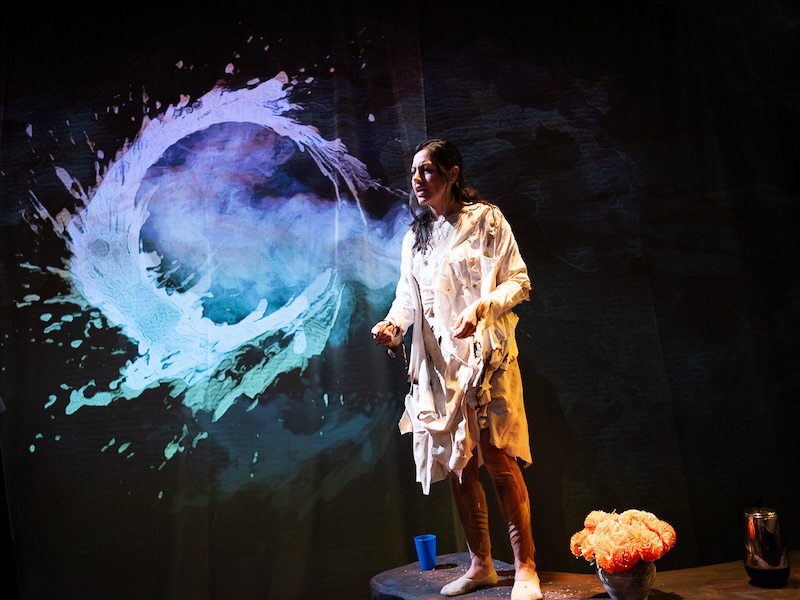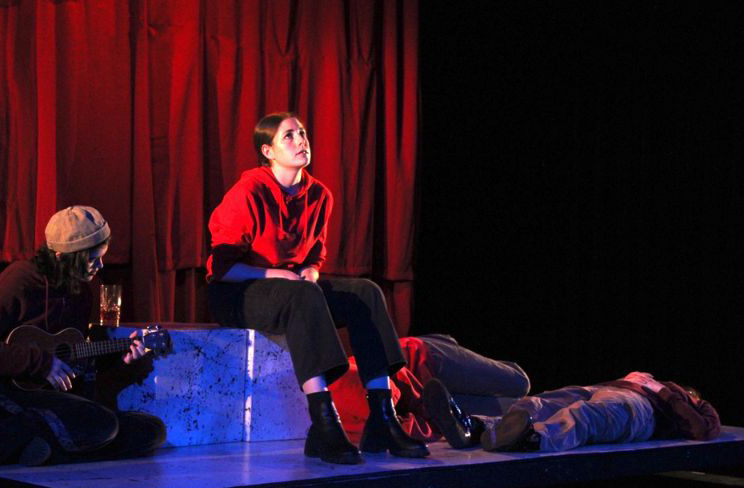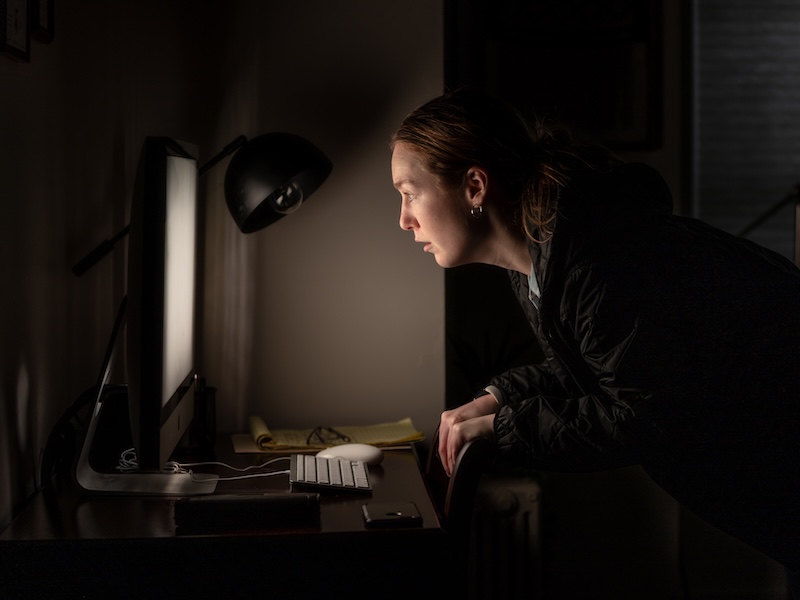By Eileen Miller
This article was originally published in DC Theater Arts here.
A ghost haunts the stage from the opening moments of Woman on Fire. And yet, she is not the only spectre lurking in this Arizona border town. Set in the shadow of the September 11 terror attacks in a country charged with trauma and paranoia, Marisela Treviño Orta’s masterful ghost story explores the intersection between border politics and identity, while entreating its audience to reclaim their empathy.
Woman on Fire, directed by Elena Velasco, is making its regional debut at Creative Cauldron as a “Bold New Voices” production. Treviño Orta’s play is inspired by the ancient Greek drama Antigone, building on the tragedy’s themes and transposing them to a 2002 Arizona border town. It is to this town that Juanita (Odette Gutiérrez del Arroyo), a Mexican-American woman, has recently moved, hoping to salvage her marriage to her white border patrol agent husband Jared (Evan Crump). Latent tensions in their relationship are amplified after Paola (Lenny Mendez), the ghost of a woman who died trying to cross the border, begins visiting Juanita. When Paola asks her to complete a daunting task, Juanita is forced to reckon with the border politics and her Mexican-American identity.
Mendez’s haunting portrayal of the dead Paola is a wonder to watch. In the production’s opening moments, her ragged breathing and tormented stare capture the audience’s attention. In later scenes, she deftly conveys Paola’s pain and bitterness at her death and her frustration at Juanita’s unwillingness to release her from her suffering.
Juanita’s fear and desperation to distance herself from both the politics of the border and the ghost who died there are also central to the show. Del Arroyo delivered a nuanced performance, capturing Juanita’s naïveté and obstinacy as she clings to her husband’s politics and tries to ignore both the realities of the borderlands and their intersection with her Mexican-American identity.
Contrasts abound in this play. Juanita’s husband is a Republican border patrol agent; her sister Araceli (Nadia Palacios) is a staunch liberal and a professor of Cultural Identity and Politics at U.C. Berkeley. The living Juanita and dead Paola may have ancestors from a shared homeland, but the decision of Juanita’s to migrate north while Paola’s remained in the south led to their diverging classifications as “illegal” and “American.”
The characters’ wardrobes, designed by Nyasha Klusmann and each defined by a specific color or color palette, were masterfully employed to further reflect the contrasts between characters. Jared dresses in dark navy and military olive, reflecting his job in the border patrol. Meanwhile, practically every outfit of Juanita’s falls within a narrow range of delicate pinks, alluding to her inner naïveté. In contrast to her sister’s pale pinks, Araceli’s wardrobe consists of stronger jewel tones in orange and red, a reflection of her headstrong nature and self-confidence. The ghost Paola wears pale blue, a nod to her status as a soul who has faded from the world of the living. These costume choices skillfully supplemented the different portrayals, giving each character a distinct visual presence on stage.
And yet, through skillfully constructed monologues, Treviño Orta hints at the commonalities that lurk beneath their differences. Throughout the play, Woman on Fire’s characters — living and dead, Democrat and Republican, American and “illegal” — speak using language that echoes that of earlier monologues by other characters. At other times, they recount experiences that mirror those shared onstage by others. Despite all the characters’ differences, the parallels Treviño Orta incorporates into the dialogue reflect all that they have in common and drive them to reconnect with their empathy for one another.
Other elements of the production design are deserving of praise as well. Woman on Fire’s simple set, designed by Margie Jervis, has an understated beauty.With the principle “less is more,” the largely empty stage evokes both the Southern Arizona landscape and the gaping chasm in Juanita and Jared’s marriage.
Dark and reddish browns dominate the color scheme. Two boulder-like set pieces are the primary scenery. A blanket draped over one boulder transforms it into a couch, while a pot of marigolds and two black stools turn the other into a kitchen island. Remove these props, and the stage transfigures from Juanita and Juan’s house to the inhospitable Arizona desert. Through these simple yet effective set choices, the stage shifts between house and desert, giving the production a dreamlike quality.
Another element that contributed to this dreamlike aura was the production’s most entrancing: a sheet draped from ceiling to floor, upon which various images — designed by Julian Kelley — are projected throughout the play. At certain moments, these images bleed down the screen, amplifying the supernatural element of the production and creating an evocative visual experience.
Treviño Orta’s play is a masterful adaptation of a Greek classic, yet it is also a brilliant work in its own right. Though set over two decades in the past and based on a play written over two millennia ago, Woman on Fire is profoundly relevant to the current moment. Notably, Treviño Orta does not let the differences that divide her characters drive them apart. Instead, she humanizes border politics and sends the message that it is only through remembering our shared humanity and rediscovering empathy that we can find peace.





